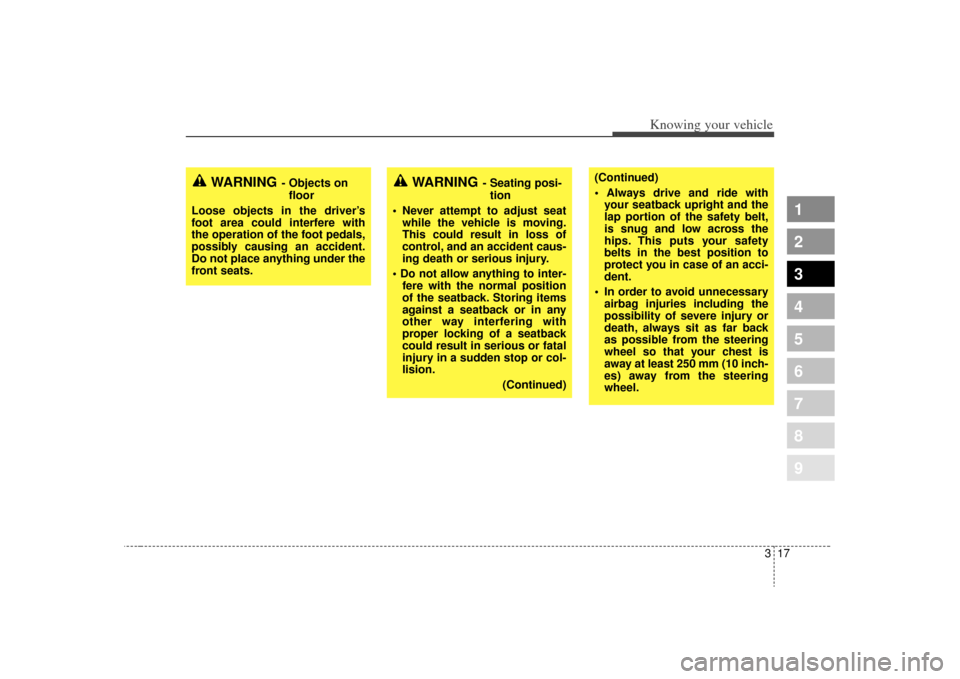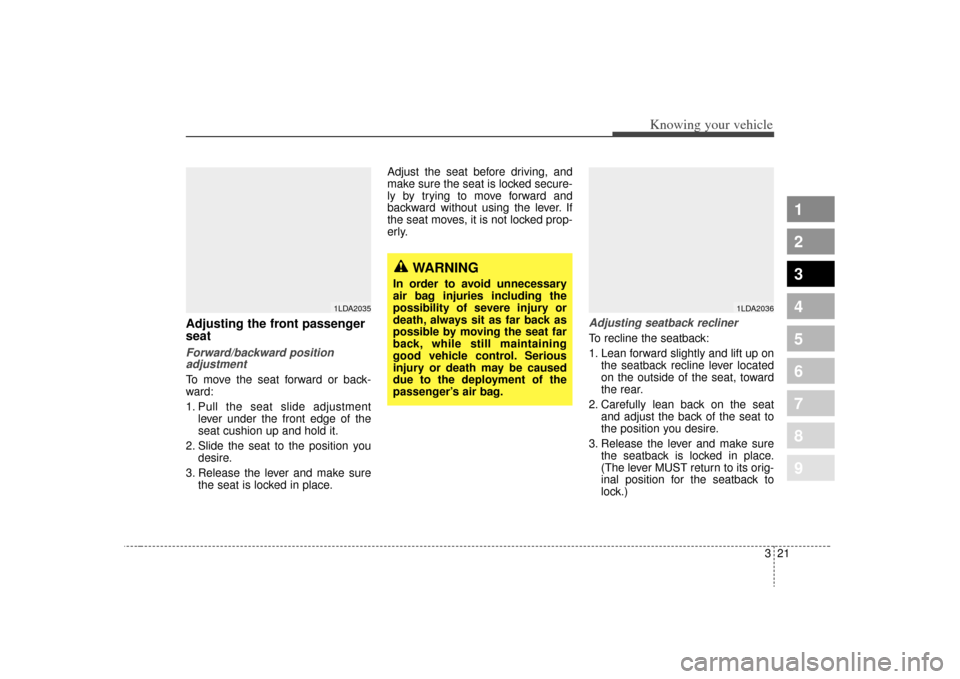Page 9 of 291
23
1
2
3
4
5
6
7
8
9
Your vehicle at a glance
INSTRUMENT PANEL OVERVIEW
1. Driver’s Air bag*
2. Light control / Turn signals
3. Instrument cluster
4. Wiper/Washer
5. Ignition switch
6. Aux
7. Hazard
8. Climate control system
9. Shift lever*
10. Passenger’s air bag*
11. Glove box
12. Audio controls*
13. Auto cruise controls*
* : if equipped
OLD006003N
Page 11 of 291
1
2
3
4
5
6
7
8
9
Keys / 3-2
Remote keyless entry / 3-3
Immobilizer system / 3-6
Door locks / 3-8
Windows / 3-13
Seat / 3-16
Safety belts / 3-27
Air bag - supplemental restraint system / 3-50
Trunk / 3-69
Hood / 3-71
Fuel filler lid / 3-73
Mirrors / 3-76
Interior lights / 3-80
Storage compartment / 3-81
Interior features / 3-83
Sunroof / 3-87
Luggage net / 3-90
Antenna / 3-91
Audio system / 3-92
Knowing your vehicle
Page 27 of 291

317
1
2
3
4
5
6
7
8
9
Knowing your vehicle
WARNING
- Objects onfloor
Loose objects in the driver’s
foot area could interfere with
the operation of the foot pedals,
possibly causing an accident.
Do not place anything under the
front seats.
WARNING
- Seating posi- tion
Never attempt to adjust seat while the vehicle is moving.
This could result in loss of
control, and an accident caus-
ing death or serious injury.
fere with the normal position
of the seatback. Storing items
against a seatback or in any
other way interfering with
proper locking of a seatback
could result in serious or fatal
injury in a sudden stop or col-
lision.
(Continued)
(Continued)
your seatback upright and the
lap portion of the safety belt,
is snug and low across the
hips. This puts your safety
belts in the best position to
protect you in case of an acci-
dent.
In order to avoid unnecessary airbag injuries including the
possibility of severe injury or
death, always sit as far back
as possible from the steering
wheel so that your chest is
away at least 250 mm (10 inch-
es) away from the steering
wheel.
Page 31 of 291

321
1
2
3
4
5
6
7
8
9
Knowing your vehicle
Adjusting the front passenger
seatForward/backward positionadjustmentTo move the seat forward or back-
ward:
1. Pull the seat slide adjustment
lever under the front edge of the
seat cushion up and hold it.
2. Slide the seat to the position you desire.
3. Release the lever and make sure the seat is locked in place. Adjust the seat before driving, and
make sure the seat is locked secure-
ly by trying to move forward and
backward without using the lever. If
the seat moves, it is not locked prop-
erly.
Adjusting seatback reclinerTo recline the seatback:
1. Lean forward slightly and lift up on
the seatback recline lever located
on the outside of the seat, toward
the rear.
2. Carefully lean back on the seat and adjust the back of the seat to
the position you desire.
3. Release the lever and make sure the seatback is locked in place.
(The lever MUST return to its orig-
inal position for the seatback to
lock.)
1LDA2035
WARNING
In order to avoid unnecessary
air bag injuries including the
possibility of severe injury or
death, always sit as far back as
possible by moving the seat far
back, while still maintaining
good vehicle control. Serious
injury or death may be caused
due to the deployment of the
passenger’s air bag.
1LDA2036
Page 37 of 291

327
1
2
3
4
5
6
7
8
9
Knowing your vehicle
Pre-tensioner seat beltYour vehicle is equipped with driver’s
and front passenger’s pre-tensioner
seat belts. The purpose of the pre-
tensioner is to make sure that the
seat belts fit tightly against the occu-
pant’s body in certain frontal colli-
sions. The pre-tensioner seat belts
can be activated together with the air
bags, where the frontal collision is
severe enough.When the vehicle stops suddenly, or
if the occupant tries to lean forward
too quickly, the seat belt retractor will
lock into position. In certain frontal
collisions, the pre-tensioner will acti-
vate and pull the seat belt into tighter
contact against the occupant's body.
If the system senses excessive seat
belt tension on the driver or passen-
ger's seat belt when the pre-tension-
er activates, the load limiter inside
the pre-tensioner will release some
of the pressure on the affected seat
belt. (if equipped)
The seat belt pre-tensioner system
consists mainly of the following com-
ponents. Their locations are shown in
the illustration.
(1)
SRS airbag warning light
(2) Seatbelt pre-tensioner assembly
(3) SRS airbag control moduleSAFETY BELTS
2GHB3002
2GHB3001
1
2
3
Page 38 of 291

Knowing your vehicle28
3
1
2
3
4
5
6
7
8
9
✽ ✽
NOTICE• Both the driver's and front pas-
senger's pre-tensioner seat belts
will be activated in certain frontal
collisions. The pre-tensioner seat
belts can be activated, where the
frontal collision is severe enough,
together with the air bags.
• When the pre-tensioner seat belts are activated, a loud noise may be
heard and fine dust, which may
appear to be smoke, may be visible
in the passenger compartment.
These are normal operating condi-
tions and are not hazardous.
• Although it is harmless, the fine dust may cause skin irritation and
should not be breathed for pro-
longed periods. Wash all exposed
skin areas thoroughly after an
accident in which the pre-tension-
er seat belts were activated.
WARNING
To obtain maximum benefit from
a pre-tensioner seat belt:
The seat belt must be worn
correctly.
The seat belt must be adjusted to the correct position.
CAUTION
Because the sensor that acti- vates the SRS air bag is con-nected with pre-tensioner seatbelt, the SRS air bag warninglight on the instrument panelwill blink or illuminate forapproximately 6 seconds afterthe ignition key has beenturned to the “ON” position,then the light should go off.
If the pre-tensioner seat belt is not working properly, thiswarning light will illuminateeven if there is no malfunctionof SRS air bag system. If theSRS air bag warning lightdoes not illuminate when theignition key is turned to “ON”,or if it remains illuminatedafter blinking or illuminatingfor approximately 6 seconds,or if it illuminates while thevehicle is being driven, pleasehave an authorized Kia dealerinspect the pre-tensioner seatbelt or SRS air bag system assoon as possible.
Page 39 of 291

329
1
2
3
4
5
6
7
8
9
Knowing your vehicle
Safety belt restraint system
WARNING
Pre-tensioners are designedto operate once. After activa-
tion, pre-tensioner seat belts
must be replaced. All seat
belts, of any type, should
always be replaced after they
have been worn during a colli-
sion.
Do not attempt to inspect or replace the pre-tensioner seat
belts yourself. This must be
done by an authorized Kia
dealer.
CAUTION
The pre-tensioner seat beltassembly mechanisms becomehot during activation. Do nottouch the pre-tensioner seatbelt assembly for several min-utes after they have been acti-vated.
WARNING
Do not strike the pre-tensioner seat belt assemblies.
Do not attempt to service or repair the pre-tensioner seat
belt system in any manner.
Improper handling of the pre- tensioner seat belt assem-
blies, and failure to heed the
warnings not to strike, modify,
inspect, place, service or
repair the pre-tensioner seat
belt assemblies may lead to
improper operation or inad-
vertent activation causing
serious injury.
Always wear the seat belts when driving or riding in a
motor vehicle.
If the vehicle or pre-tensioner seat belt must be discarded,
contact an authorized Kia
dealer.
WARNING
- Safety belts
To minimize the risk of serious
or fatal injury in an accident, the
driver and all passengers
should use the appropriate
safety restraints for their age
and size. The presence of air
bags does not change the need
to be properly restrained by a
safety belt or size-appropriate
child restraint. In fact, air bags
are designed to work the best
when passengers are correctly
restrained in the vehicle. Be
sure you are familiar with the
information in this section,
including the information on
infant and child restraints. Read
the safety warnings on the sun
visors of your vehicle also.
Page 40 of 291

Knowing your vehicle30
3
1
2
3
4
5
6
7
8
9
We strongly recommend that the
driver and all passengers be proper-
ly restrained at all times by using the
safety belts provided with the vehi-
cle. Proper use of the safety belts
decreases the risk of severe injury or
death in accidents or sudden stops.
In most states, and in Canada, the
law requires their use.
All seats have lap/shoulder belts.
Inertial locks in the safety belt retrac-
tors allow all of the lap/shoulder safe-
ty belts to remain unlocked during
normal vehicle operation. This allows
the occupants some freedom of
movement and increased comfort
while using the safety belts. If a force
is applied to the vehicle, such as a
strong stop, a sharp turn, or a colli-
sion, the safety belt retractors will
automatically lock the safety belts. Since the inertial locks do not require
a collision in order to lock up, you
may become aware of the safety
belts locking while braking or going
around sharp corners.
Always use the rear seat position(s)
to install your child restraint(s).
Never install a child restraint system
in the front passenger position, as an
inflating air bag could cause serious
or fatal injury to a child in that posi-
tion.
The rear safety belts use a special
auto-lock feature designed to allow a
child restraint to be used in these
positions without an added locking
clip. They normally lock only under
extreme or emergency conditions
(emergency lock mode). However
they can be adjusted so that they
remain in fixed and locked when a
child restraint system is placed in
these positions. (Use this auto-lock
mode only to secure a child restraint,
never for passengers restrained by
the safety belts.) Page 3-44 gives
instructions on placing the safety belt
in the auto lock mode.
The drivers safety belt can only oper-
ate in the emergency lock mode.